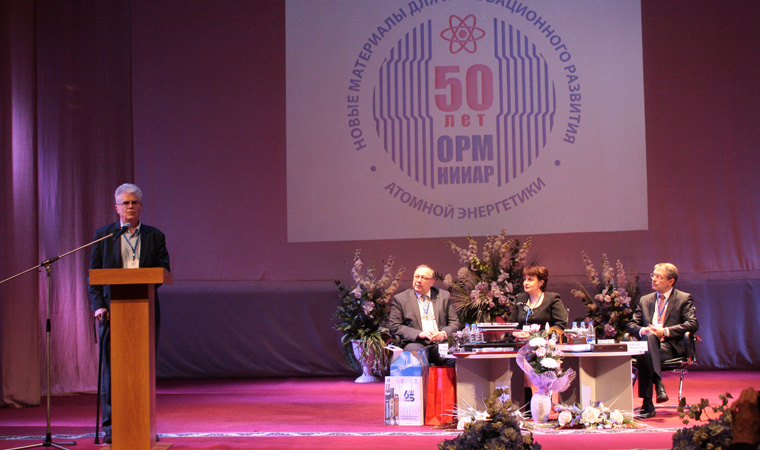
Valuable materials
back to contentsThe conference included 43 plenary and 57 poster papers made by speakers from the world’s leading companies carrying out research in the field of modern material science. The number of participants and scale of the conference are conditioned, first, by the topic, which is acute for the world nuclear power. Competitiveness and development of the nuclear industry cannot do without material science. Fuel consumption efficiency and improvement of NPP safety systems are main tasks of energy engineers across the world.
The interest in the event is explained also by great respect for the hero of the day, i.e. the material science complex of NIIAR. Today, it is Europe’s largest hot laboratory with 60 shielded chambers, cutting-edge research equipment, and highest level of expertise. In the recent years it has hosted over 80% of all in-pile tests and post-reactor examinations of fuel rods and materials done in Russia. Today in Russia NIIAR is the only facility that carries out full-scale studies of spent nuclear fuel from NPPs. Over the several recent years the institute has fulfilled more than 20 international contracts with leading research centers of Canada, China, Czech Republic, France, Germany, Japan, South Korea, and USA.
Come together
Welcoming the conference participants, NIIAR director Sergey Pavlov noted: “I am very glad that the political disagreements between Russia and leaderships of some countries haven’t prevented us from coming together to celebrate the 50-th anniversary of the institute’s material science complex. I hope that our scientific cooperation will develop and outcomes of research being done in NIIAR will serve to development of new materials for peaceful nuclear power, help to improve efficiency of fuel consumption at NPPs, and enhance their safety systems.”
“We started preparing the conference as back as March last year, Yelena Zvir, head of RMSD, says. “It cost a lot of effort. Of cause, we were upset by the fact that few days before the conference it came out that of 40 foreign guests only 24 would come. The French, Ukrainians and many of Americans didn’t come. No one hid the reason. But, thank goodness, most of the foreign colleagues are here. These are people the institute has cooperated with for many years already. Our good old friend, Frank Garner (president of Radiation Effects Consulting) has come in spite of age and health condition.”
Garner himself is very pleased with the invitation and recollects, saying that for the first time he came to Russia in 1989 and was stricken by the large scale of the programs implemented in the institute as compared with what was done in the West. Since then he has visited the laboratory for 40 times already. He says, I admire time and again the level of the Russian science and education, especially people. I have worked with many NIIAR’s scientists and well familiar with participants of the today’s conference, he added.
Executive vice president of the U.S. company TerraPower David McAlees emphasized that the company has cooperated with NIIAR for four out of eight years of the company’s existence. We greet RMSD with the 50-th anniversary and hope to work together as long, McAlees concluded.
Work to breakthrough
The institute specialists told about already conducted and upcoming works at NIIAR for the Russian nuclear power, such as the development of fuel for fast neutron reactors SVBR-100 and BREST-300. “The task of searching for materials for the new generation reactors is topical for all countries interested in development of nuclear power of their own,” Vladimir Risovanny, a representative of ROSATOM’s scientific unit, said.
NIIAR is ready to work to have a material science breakthrough. “Three years ago the modernization of the experimental equipment started in the department, Yelena Zvir says. “Many things were done: the new equipment was purchased and commissioned. We have huge plans. For instance, we want to move to a qualitatively new level of preparation of specimens for research that uses transmission and scanning microscopy. Focused ion beams will be used for this purpose. This technology allows making very small specimens of irradiated nuclear fuel, let alone the structural materials. We have started the first stage of the modernization of, essentially, Russia’s only complex of installations within Radiation Shielded Chamber No. 1 in Russia. It is unique because it provides for measurements of various geometric, nuclear physics and other parameters of full-size irradiated fuel rods and assemblies from all types of reactors, both Russian and foreign. All installations are in working order; each year they are used for a large volume of research for national and international customers.
The team is optimistic about the future. The most important task of the coming years is the research to justify the use of materials and components of cores of the new generation reactors. Also, the research work is under way on advanced fuel rods and assemblies of VVER-1000 reactors, fuel rod cladding materials for floating reactors and small power plants, and SVBR-100 fuel mock-ups. The work continues to justify performance of uranium-plutonium nitride fuel rods for fast neutron reactors BREST-OD-300 and BN-1200.”
Unique NIIAR
Technical tours to NIIAR site were organized for the participants. They visited the material science complex and research nuclear reactors BOR-60 and SM. The guests had an opportunity to have a look at where and how the experimental works to justify performance of new fuel and structural materials for reactor cores were carried out.
Larisa Serke, the head of the Nuclear Fuel Department at Paks NPP (Hungary) emphasized, we should note that all specialists who work at Paks NPP highly appraise the contribution NIIAR, and especially RMSD, makes in the improvement of power reactor fuel efficiency and reliability. We are grateful to NIIAR for these results and we will never forget the support NIIAR rendered to the plant to eliminate the consequences of the incident occurred in 2003, she said.




